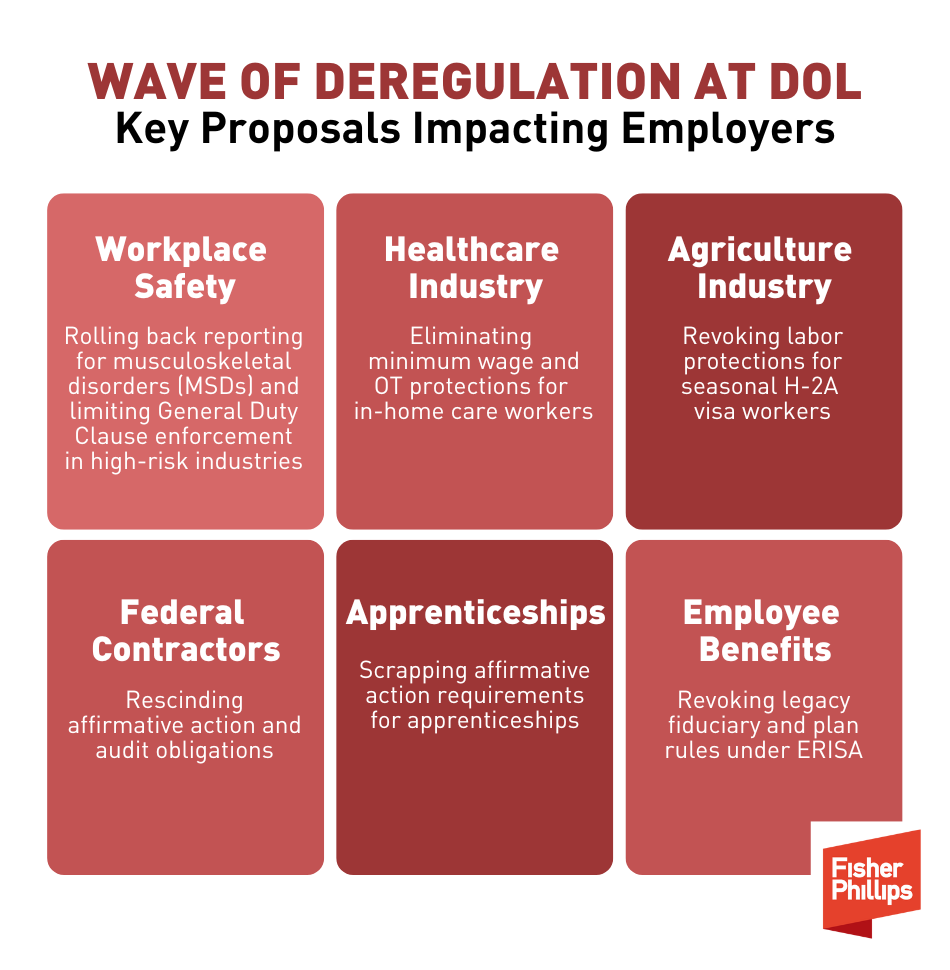Wave of Deregulation Hits DOL: What Employers Need to Know About the 60+ Rules on the Chopping Block
Insights
7.08.25
The U.S. Department of Labor just quietly launched one of the most sweeping deregulatory efforts in recent memory, advancing over 60 proposals that could reshape workplace rules across industries. From overtime and minimum wage exemptions to cuts in affirmative action and workplace safety oversight, the July 1 rollout is being called one of the most ambitious federal red tape rollbacks in recent decades. Here’s what your business needs to know – and what to watch for next.
What Just Happened?
Without much fanfare, the Department of Labor (DOL) unveiled a broad set of regulatory rollbacks in response to President Trump’s executive order calling for federal agencies to rescind 10 regulations for every new one issued. Secretary of Labor Lori Chavez-DeRemer’s announcement called it “the most ambitious proposal to slash red tape of any department across the federal government.”
Key proposals include:
- Workplace Safety: Rolling back employer reporting requirements for musculoskeletal disorders (MSDs). While the Biden-era OSHA released a memorandum that clarifies when employers are required to record and report such injuries, that memo would be jettisoned if the current DOL has its way.
- Workplace Safety, Part Two: Amending OSHA’s use of the General Duty Clause and other safety enforcement mechanisms to limit enforcement in professional activities that are inherently risky, such as sports and entertainment. While worker safety enforcement could narrow, this proposed rollback may face legal challenges given its potential impact. You can read more about this proposal here.
- Healthcare Industry: Eliminating minimum wage and overtime protections for millions of in-home care workers under the FLSA. Employers in home healthcare and companionship services may see a significant shift if exemptions are finalized. (But note that certain states like California have more nuanced rules governing pay for these workers.)
- Agriculture Industry: Revoking some Biden-era employment protections for seasonal H-2A visa workers, including protections related to collective action and concerted activity. Agricultural employers could see reduced labor organizing exposure, but litigation risks would remain. The agency recently announced that it would suspend enforcement of what it labeled “the Biden Administration’s burdensome 2024 farmworker rule,” but last week’s move would make it official. (Remember that certain states, including California and New York, separately recognize agricultural employees’ right to organize under state law.)
- Federal Contractors: Rescinding anti-discrimination regulations enforced by the Office of Federal Contract Compliance Programs (OFCCP). The potential dismantling of this agency would remove long-standing affirmative action and audit obligations. Read more about this proposal here.
- Apprenticeships: Scrapping affirmative action requirements for registered apprenticeship programs. Training programs would face fewer diversity-related requirements – but this move could risk backlash if participation gaps worsen.
- Employee Benefits: Revoking legacy fiduciary and plan rules under ERISA.
Most of these are formally classified as “deregulatory actions” under the January executive order, and many more are pending at the White House budget office.
What’s Missing?
Curiously absent from last week’s announcement was an update regarding the controversial independent contractor rule that still remains from the Biden-era DOL. While the agency announced on May 1 that its Wage and Hour Division (WHD) investigators would no longer apply the 2024 rule’s complex analysis in current enforcement matters, the rule remains on the books and will be applied by courts in private litigation until the DOL formally takes steps to remove it.
What’s Next?
The July 1 release was just the opening bell. Most of the 60+ actions are proposals at this stage, meaning the formal rulemaking process is only beginning. Here’s how that process will unfold:
- Federal Register Notices: Expect proposed rules to be published soon in the Federal Register, kicking off public comment periods (typically 30 to 60 days).
- Comment Opportunities: Employers, trade groups, unions, and individuals will have the chance to submit feedback. These comments can influence the final rule or delay implementation.
- OMB and Interagency Review: Several rules are still under review at the White House Office of Information and Regulatory Affairs (OIRA), which can lead to revisions or hold-ups.
- Final Rule Stage: After comments are reviewed, DOL will publish final rules, some by year-end, others potentially in 2026 depending on complexity and volume of feedback.
- Litigation Likely: Expect legal challenges to accompany high-impact changes, especially those affecting worker safety, migrant labor rights, or compensation protections.
- Patchwork Compliance Risks: With courts less likely to issue nationwide injunctions, employers may face a mix of enforceable and enjoined rules depending on jurisdiction.
What Should Employers Do Now?
Here are five steps to take as this regulatory shift unfolds.
1. Track the Proposals Closely
Many rules are still in the proposal stage or awaiting OMB clearance. Be cautious before relying too heavily on yet-to-be-finalized rules. Designate someone on your team – or outside counsel – to monitor developments weekly. Make sure to sign up for Fisher Phillips’ Insight System to get the latest news directly to your inbox.
2. Assess Impact on Your Business Operations
Healthcare, agriculture, federal contracting, and companies with apprenticeship programs are particularly affected. Map out what rule changes could ease compliance or create exposure.
3. Watch for Legal Challenges
Expect advocacy groups and state AGs to file lawsuits, especially concerning OSHA, H-2A labor rights, and wage-and-hour standards. But also recognize that we live in a new era where it will be more challenging for one lower court judge to shut down the DOL’s efforts across the entire country, and we may end up seeing a compliance patchwork unfold.
4. Evaluate Public Perception Risks
Pullbacks on safety, child labor, or diversity requirements may invite criticism or union organizing efforts. Review your external messaging, employee communications strategies, and employee relations actions accordingly.
5. Engage with Industry Associations and Regulators
Amplify your voice through trade groups to help shape final rule language and comment periods. This is a rare window for employer input on a sweeping federal overhaul. You can also make your voice heard directly by working with FP Advocacy.
Conclusion
We will continue to monitor developments related to all aspects of workplace law. Make sure you are subscribed to Fisher Phillips’ Insight System to get the most up-to-date information. If you have questions, contact your Fisher Phillips attorney, the authors of this Insight, or any attorney on our Government Relations team.
Related People
-
- Sheila M. Abron
- Partner
-
- Sheldon J. Blumling
- Partner
-
- Benjamin M. Ebbink
- Partner
-
- Rebecca Hause-Schultz
- Partner
-
- Todd B. Logsdon
- Partner
-
- Jennifer B. Sandberg
- Regional Managing Partner
-
- Hannah Sweiss
- Partner
-
- J. Hagood Tighe
- Partner and Co-Chair, Wage and Hour Practice Group
-
- Joshua H. Viau
- Co-Regional Managing Partner









